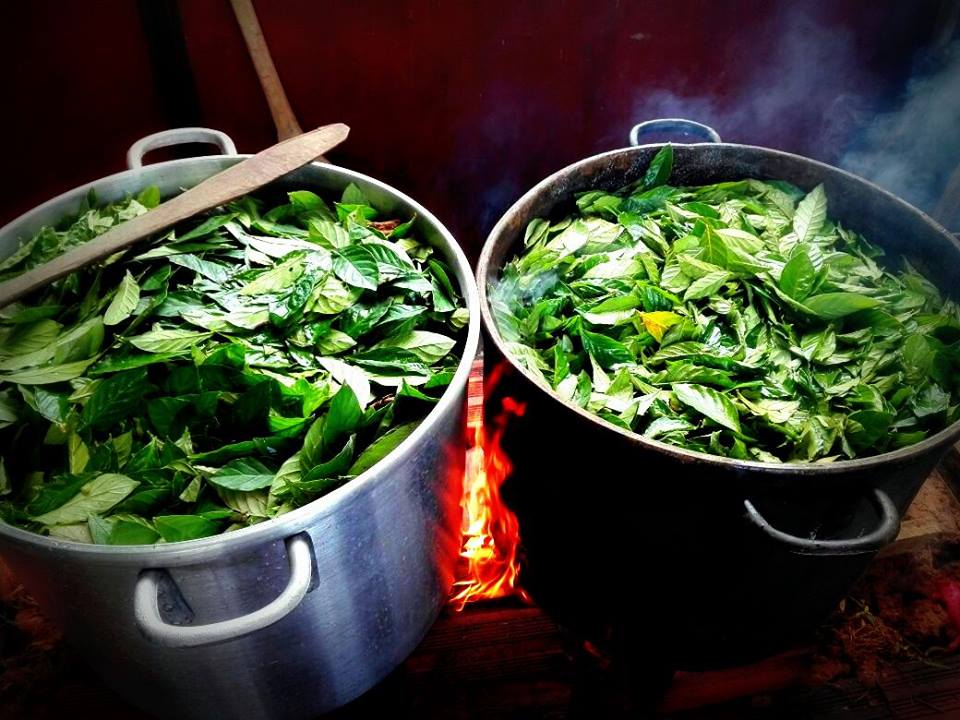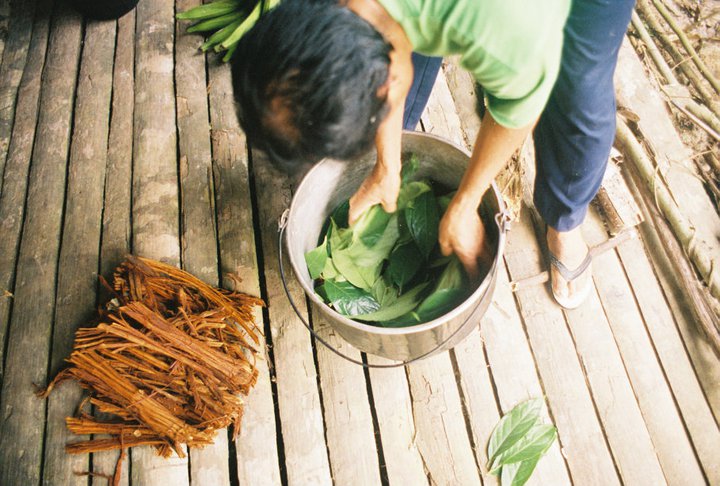Ayahuasca Drink
Ayahuasca is the term used both to refer to the Banisteriopsis caapi vine and to describe the psychoactive drink.
The sacred drink Ayahuasca is obtained by cooking two species of plants endemic to the Amazon rainforest: the Banisteriopsis caapi vine, which contains beta-carboline derivatives: harmine, harmaline and tetrahydroharmine; and the shrub Psychotria viridis Ruíz & Pavón, which contains DMT (N, N-dimethyltryptamine), a tryptamine derivative.
To a lesser extent, other plants are used in the preparation of the drink.
In addition to Banisteriopsis caapi, other species of the same genus are used to a lesser extent, such as Banisteriopsis longialata or Banisteriopsis lutea, among others.
On the other hand, in addition to the Psychotria viridis shrub, it is rarely replaced by other species of the same genus, such as: Psychotria or Psychotria batiskawa, among others.
Mckenna (1998a) describes that in Colombia and Ecuador, in addition to the genus Psychotria, another plant from the Malpighiaceae family is also used, which contains a high concentration of DMT: Diplopterys cabrerana. (OTT, 1994; MCKENNA et al, 1998a).

History of the Ayahuasca Drink
It is not known with certainty where, how or when the practice of its use began; The first archaeological evidence, such as vases and statuettes, date between 1500 and 2000 BC), which, being related to the use of other psychoactive plants, makes it difficult to know their true origin. (Naranjo, 1986, Mckenna, 1998)
Botanical studies on the species used in the preparation of Ayahuasca began in 1851, when the English botanist Richard Spruce collected some specimens of the liana used in the drink of the Brazilian Indians of the Tukano tribe, classifying it as Banisteria caapi, which, In 1931, it was reclassified by Morton as Banisteriopsis caapi. The other species used, the shrub Psychotria viridis, which was first described by Ruíz & Pavón in 1779.
This drink is also known by the names hoasca, yagé, caapi, mihi, natema, pindé, daime, vegetal, among others; Luna mentions at least 72 tribes that use the drink and 42 different names. (Luna, 1986, Labate, 2004).
Cultural aspects of the Ayahuasca drink
In the statement of Siã Kaxinawá, head of the T.I. do Rio Jordão, tells us about ayahuasca:
“Ayahuasca is the science of the spirit, nature, and the laws of the world. We do not take it as a joke: We drink Ayahuasca to see and deal with matters of a certain seriousness. To prepare the drink, we go to the mountains to look for vines and leaves. When we find them, we cut the vine along with the leaf.
When we got home we left it to continue the next day, since it is usually late.
The next day, very early in the morning, we begin its preparation, which takes us all day. At seven in the afternoon we had a drink with our companions, then we sang. Each one takes everything he wants. The vine teaches us many things. “
(SIÃ KAXINAWÁ apud MONTE, 1984)

Family: Malpighiaceae.
Scientific name: Banisteriopsis caapi (Spruce ex Griseb) Morton.
Other names used: Yagé, Bejuco bravo; Caapi (Brazil); Mado, Mado bidada and Rami-Wetsem (culina); Ñucñu huasca and Shimbaya huasca (Quechua): Kamalampi (piro); Punga huasca Rambi and Shuri (sharanahua); Yellow Ayahuasca; Ayawasca, Nishi and Oni (shipibo), black Ayahuasca, white Ayahuasca; Ayahuasca heaven; Shillinto Natema (jibaro); Golden vine (Colombia); Mi-hi (cubeo); Amarron huasca and Inde huasca (ingano); Yajé (kofan); Shuri-fisopa and Shuri-oshinipa (sharanahua), Napi; Nepe.
Leaves: It has opposite leaves, 15 to 17 cm long and 6 to 9 cm wide with an ovate-lanceolate shape and acuminate apex, its base has two glands and it has an obtuse or rounded shape.
Inflorescence: Axillary, with 4 flowers, 5 cm long, sometimes in paniculate umbels. Flowers hermaphrodite, pentamerous; calyx with 8 basal glands; corolla with yellow, pale pink or reddish-vermilion petals, with ten stamens. Tricarpelar gynoecium, sigmoid styles.
Fruit: Samara slightly strigosa, oblong, with leathery and sinuous dorsal wing, 3 cm long and 0.8 cm wide.
Climate: It lives in tropical and subtropical climates, with temperatures between 20 and 26ºC, rainfall of 1,800 to 3,500 mm/year, and altitudes of up to 1,500 meters above sea level.
Soil: Sandy-clayey with abundant organic matter. Biotope of natural populations: It lives in high soils, away from the banks, in flooded soils only with high growth, virgin forest, under conditions of intermediate light or shade.








